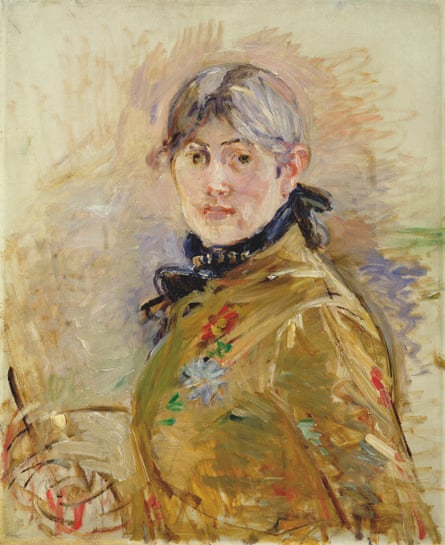“What a shame they are not men,” Édouard Manet wrote of Berthe and Edma Morisot, upon meeting the gifted young artists in 1868. Their paintings were, he feared, almost certain to be ignored by the male establishment. It is true that Edma gave up art soon afterwards, marrying a naval officer and moving to Brittany. But Berthe Morisot (1841-95) continued to paint right up to her early death of pneumonia, exhibiting annually at the Paris Salon and making the most singular and radical images of contemporary women, some of them in the act of painting too. Even so, Manet’s prediction would carry a terrible truth.
The Morisot sisters were born to an upper middle-class family who nurtured their aspirations with a private studio and a supply of famous tutors. Corot taught them to paint outdoors in the landscape, an exceptional liberty for stifled Parisiennes. Renoir and Baudelaire became friends, and Berthe Morisot sat for Manet on at least 11 occasions. His paintings are so struck with her dark-eyed intelligence – she is the startling woman leaning on the railing of his 1868 work The Balcony – that historians have wondered about their relationship, their letters and intense conversations. But Morisot never painted Manet.
She scarcely painted men at all, and her world of women is infinitely subtle and secretive: solitary figures reading, thinking, looking out of luminous windows in hushed interiors, seated in gardens where they appear almost consubstantial with the foliage, dressed in modish clothes that seem to have nothing to do with their inner existence.
The opening room at Dulwich Picture Gallery is a revelation of heads turning away into thought: pensive, averted, eyes eluding our own. One woman is pictured from behind, dress slipping from shoulder as she gets ready for some event you feel she scarcely wants to attend. Another leans back in a chaise longue, gaze slightly askance, the pale green radiance around her like moonlight in daytime. A third holds up her fan like a stop sign.
The only sitter who looks directly back is Morisot herself, in debonair jacket and cravat, tousled hair gathered into a ribbon. Her palette and brush are a medley of illegible marks and on her breast is pinned what appears to be a Légion d’honneur, but turns out to be a witty arrangement of blue and red blossoms.
Morisot eventually married Manet’s brother Eugène at the age of 33, and gave birth to their daughter, Julie, four years later. Children appear everywhere in her art. Girls in the grass, on the beach, clutching a doll, yarning away to the home help, in bed waiting for a story, listening rapt to that story, watching the nanny sew.
Julie is flapping about with a pet chicken in her lap while the young woman who has care of her tries to take an interest, but her thoughts are clearly elsewhere – lunch, a boy, a better job? Julie is up a tree, wears her hair in bunches, or plucks a mandolin. In one tremendous portrait from 1893, possibly now bearing the influence of Munch and other Scandinavian artists in Paris, she appears in mourning dress for her father, who had recently died.
One hand strays to the empty place on the sofa beside her, the other caresses the outstretched throat of a dog, seen from behind, leaning restlessly into her. Morisot has an extraordinary gift for the adolescent’s unformed in-between features, as for an atmosphere of both absence and presence.
This portrait is on loan from the Musée Marmottan Monet in Paris, where Morisot plays side act to Monet. Almost all of her surviving works belonged to the family when she died, and even now Morisot is not widely displayed in public collections. Which is why it is surprising that 13 of 43 exhibits at Dulwich are by men; and so few of Morisot’s most famous paintings are here.
There is a scholarly reason. The exhibition is concerned with the influences contemporary French critics discovered in her art: namely Fragonard and Boucher, to which the curators add Gainsborough, Reynolds and other English artists Morisot saw on honeymoon in London (some of them, quite possibly, at Dulwich Picture Gallery itself).
Morisot’s mother was the great-niece of Fragonard. Renoir and other admirers made the comparison. Morisot made copies of Boucher, too. There is something of the flash and dash of these 18th-century masters in her brushwork, but alas this perfectly good thesis pushes Morisot backwards into the past.

And while it is wonderful to see a Watteau or Chardin, it clouds the picture, so to speak, even more. It is hard enough to get a focus upon Morisot’s way of looking and painting over time as it is. Not least for the generations who weren’t born when the only other Morisot exhibition took place in the UK back in 1950.
But that elusiveness is the very strength of her art, as it seems. Brushstrokes shiver, tremble and fly, radiating like cartoon exclamations or rippling away into thin air. She paints a silvery haar overlaid with bright vectors that dazzle the eye. A quick, lithe line ribbons through clothes or drafts in dark eyebrows and eyes, pinning it all together.
Perhaps character is destiny, in art as in life. It would be hard to think of an impressionist with a more evanescent and shifting technique, more absorbingly strange and indeterminate surfaces, into which you look as if seeking clues to the ever-changing movements of a mind. Morisot never settles into a trademark look, a fixed and recognisable style. She is nothing like the men.

